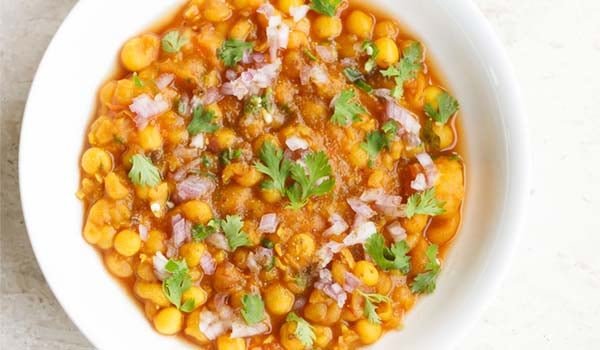Ghugni is a hearty and flavorful Indian road meals dish made with dried white peas simmered in a spiced onion-tomato curry. Generally loved in Jap India, particularly Bengal, Bihar, Odisha and Assam, Ghugni Recipe is usually tempered with mustard oil, ginger-garlic paste and a touch of bhaja masala or garam masala. Topped with chopped onions, inexperienced chilies, coriander leaves and a squeeze of lemon, this dish is ideal as a snack or gentle meal, particularly when paired with toasted bread, luchi or poori.
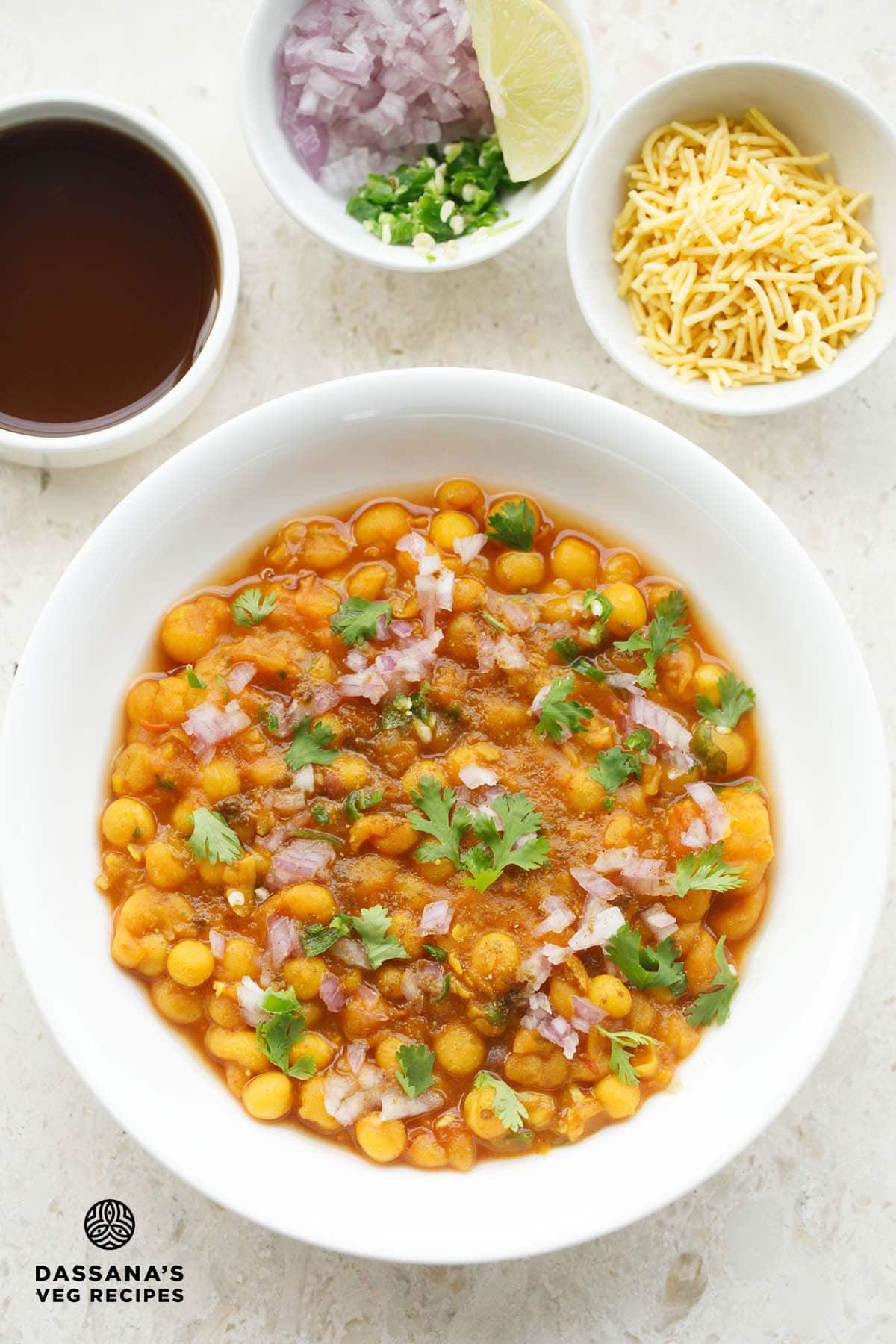
About Ghugni
This can be a one-pot Kolkata-style Ghugni Recipe that I realized from a good friend’s mother – she makes a completely scrumptious model!
To arrange this Ghugni, you’ll have to soak dried white peas for about 8 to 9 hours, so a little bit advance planning is required. After that, the remainder comes collectively simply utilizing a stovetop strain cooker.
The Ghugni Recipe consists of bhaja masala, a aromatic roasted spice mix, however you may simply substitute it with garam masala if wanted – it nonetheless seems nice.
What’s Bhaja Masala?
Bhaja Masala is a traditional Bengali spice combine, created by dry roasting spices resembling cumin, coriander, and fennel seeds, then grinding them right into a aromatic powder.
It has a heat, smoky aroma and is usually added as a completion to dishes like Ghugni, chaat and dal for an additional burst of taste.
This versatile masala enhances the style of snacks and curries whereas reflecting the depth and ease of Bengali delicacies. Its freshness is finest preserved when ready in small batches at residence.
About This Recipe
For this Ghugni Recipe, the spices are tempered in mustard oil, which helps convey out their aroma and taste. Then, onions, tomatoes, ginger, garlic and spices are sautéed collectively earlier than including the soaked peas and water. Every part is strain cooked till the peas are delicate and barely mushy.
Remember the fact that the cooking time could differ relying on the standard of the peas. The ultimate consistency of this dish needs to be excellent – not too watery, however with a creamy, barely thick gravy that outcomes from cooking the peas totally.
As soon as executed, you may flip it into Ghugni chaat by topping it along with your favourite chutneys and garnishes. Frequent toppings embrace chopped onions, inexperienced chilies, sev, recent coriander and lemon juice.
Within the genuine Kolkata model, tamarind water is used so as to add a tangy kick. However for those who favor a candy and tangy taste within the Ghugni Recipe, Tamarind Chutney is a superb various – it provides depth with its mix of sweetness, spice and tang.
Personally, I really like utilizing tamarind chutney as a substitute of tamarind water as a result of it enhances the delicate, savory peas with candy and tangy notes, whereas the toppings usher in crunch, warmth and freshness.
Ghugni normally has a touch of sweetness too, because of a contact of sugar. Be happy to regulate that to your style – skip it or add a bit extra for those who prefer it sweeter.
Ghugni vs Ragda
Though each dishes are made utilizing white peas, they differ in taste and objective. Ragda, a Maharashtrian preparation, is usually milder and serves as a base for chaats.
Alternatively, Ghugni, in style in Jap India, is extra strong and spiced, usually loved by itself or paired with gadgets like potato tikkis to create dishes resembling Ragda Patties.
My Kolkata Meals Journey
I’ve visited Kolkata a couple of instances and completely liked the road meals there. I attempted Puchka, Jhal Muri, Aloo Kabli, Ghugni, Shingara, Telebhaja and naturally, the sweets (mishti).
The flavors have been so distinctive and vibrant, every chew took me deeper into town’s wealthy culinary tradition. I even recreated a couple of sweets at residence, like Rasgulla, Sandesh, Chamcham, and Mishti Doi, and shared the recipes on my weblog.
Kolkata’s meals really captures the essence of town, and each time I return, I’m reminded of the colourful flavors and the heat that fill every dish.
Step-by-Step Information
How one can make Ghugni
Soak Dried White Peas
1. First, rinse 1 cup dried white peas totally in water a number of instances. Soak the rinsed white peas in 3 cups of water for 9 to 10 hours or in a single day.
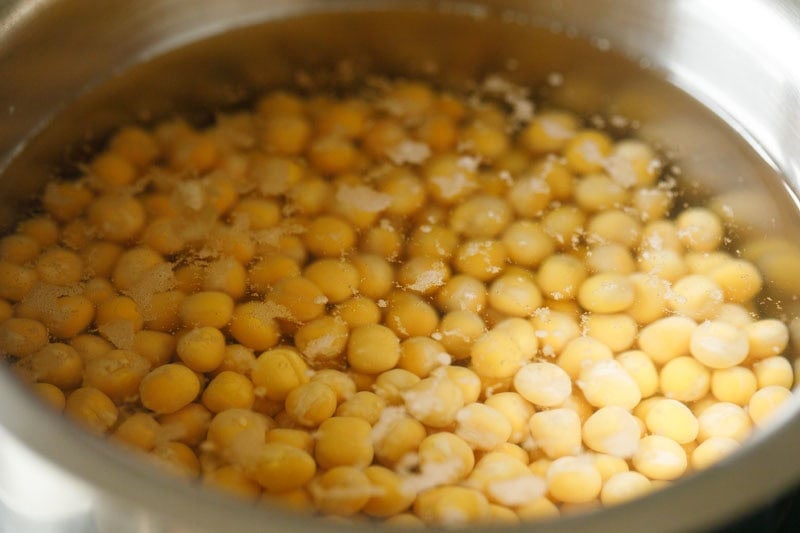

2. By subsequent day, the peas will swell and plump in dimension. Drain the water.
Rinse the dried peas a couple of instances once more with recent water. Once more drain all the water and set the soaked peas apart.
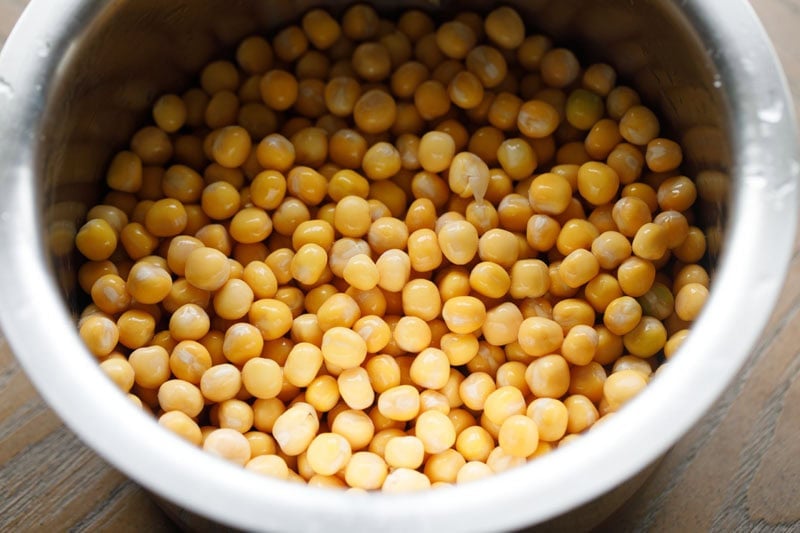

Make Onion-Tomato Masala
3. Place a 3-liter strain cooker on the stovetop. Preserve warmth low or medium-low.
Add 2 tablespoons mustard oil and let it turn out to be scorching. Add the next spices:
- 1 inch cinnamon stick
- 2 cloves
- 1 inexperienced cardamom
- 1 dried Kashmiri purple chili (seeds eliminated and halved)
Permit the spices to crackle on low to medium-low warmth.
At this level you too can add ½ teaspoon cumin seeds. However since I’ve added cumin powder later, I selected to not add the cumin seeds.
Including purple chilies are optionally available. Guarantee to make use of a milder selection, as a warmer one will make the dish very spicy.
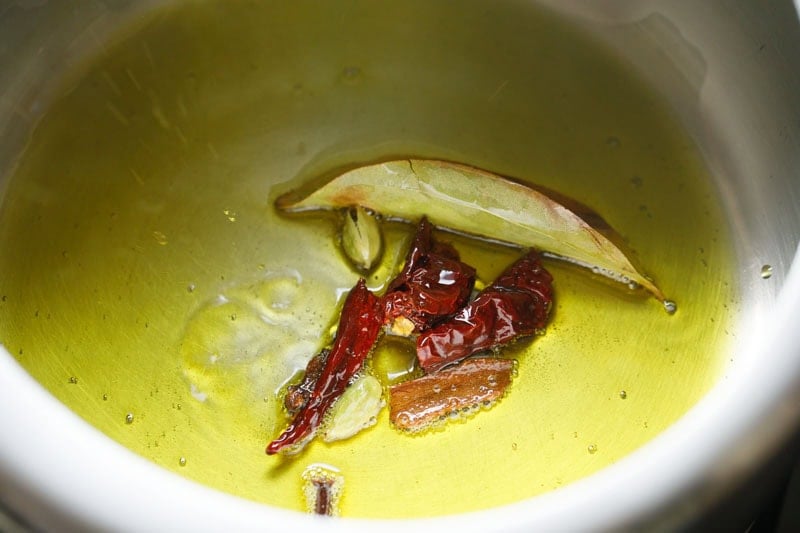

4. Add in ⅓ cup finely chopped onions.
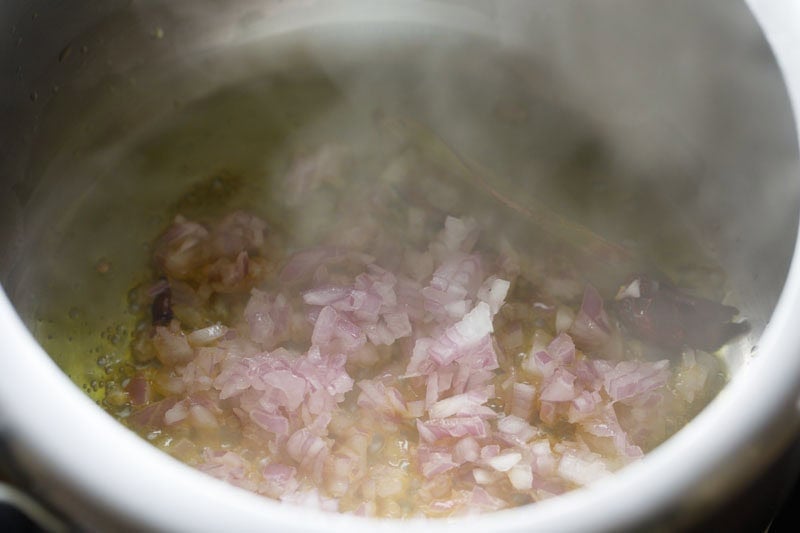

5. Sauté till onions are softened or a lightweight golden.
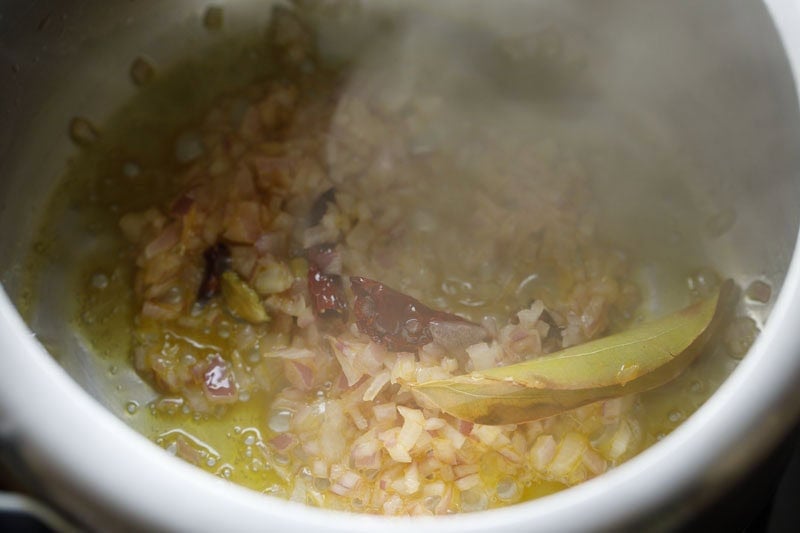

6. Add 1 teaspoon ginger-garlic paste.
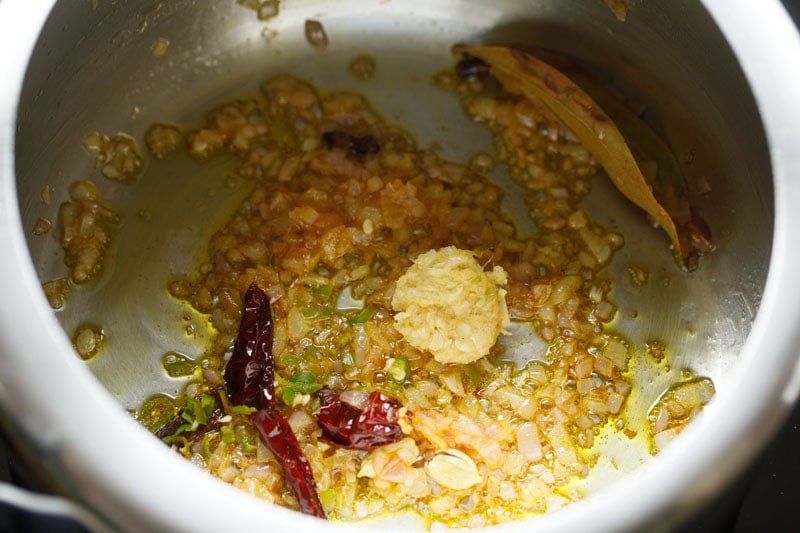

7. Sauté for about 20 to 30 seconds on low warmth or till their uncooked aroma dissipates.
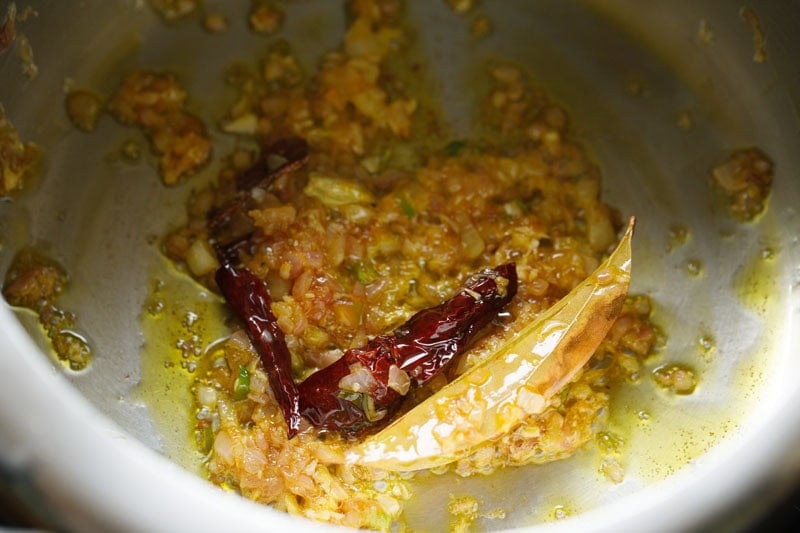

8. Add ½ cup finely chopped tomatoes and sauté on medium-low to medium warmth for about 2 minutes.
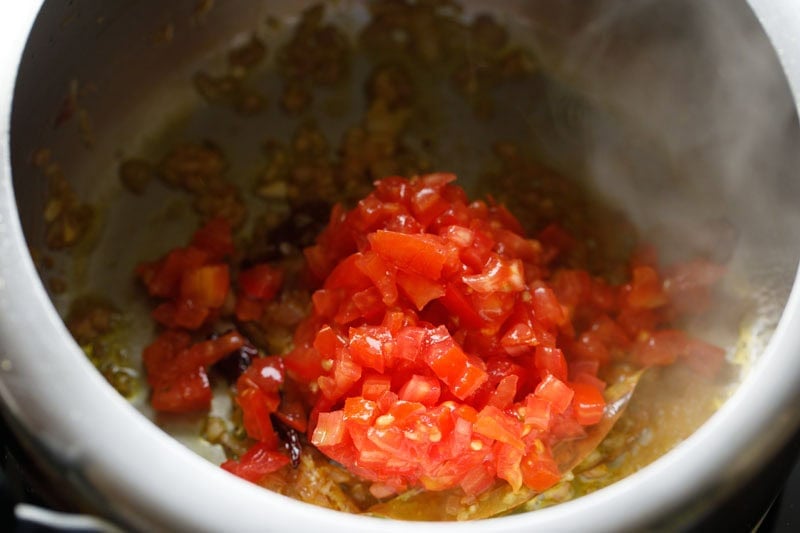

9. Subsequent add the bottom spices:
- 1 teaspoon Kashmiri purple chili powder
- ½ teaspoon turmeric powder
- 1 teaspoon cumin powder
- 1 teaspoon coriander powder
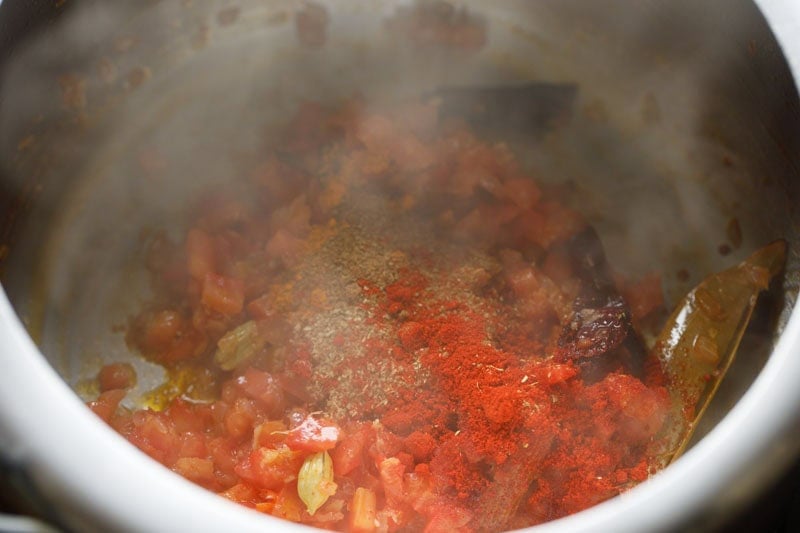

10. Combine totally and sauté till the onion-tomato masala seems shiny with the tomatoes softened utterly. Additionally, you will see a little bit of oil separating on the sides.
If the masala begins sticking onto the cooker, add a splash of water and blend.
It can be crucial that the bottom spices prepare dinner effectively.
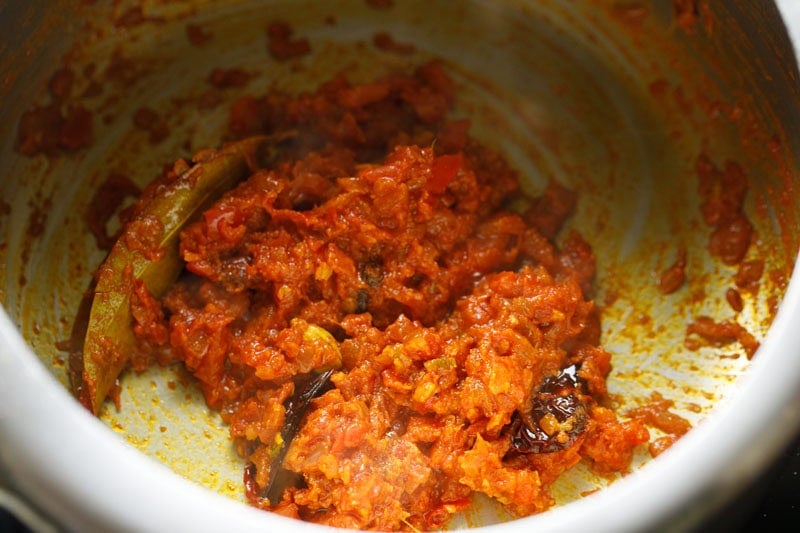

Make Ghugni
11. Add the soaked and rinsed peas, ½ to ⅔ cup chopped potatoes and season with ¼ teaspoon sugar and add salt in keeping with style.
You can add barely extra sugar for those who like.
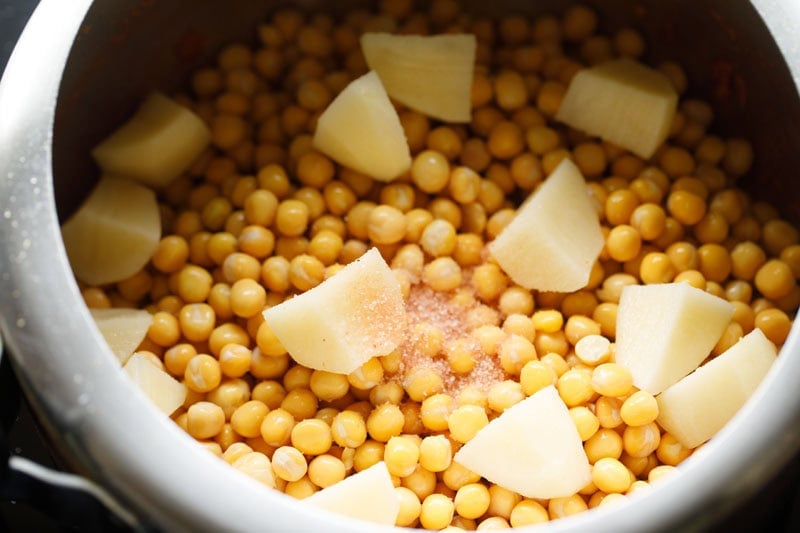

12. Stir and blend to mix.
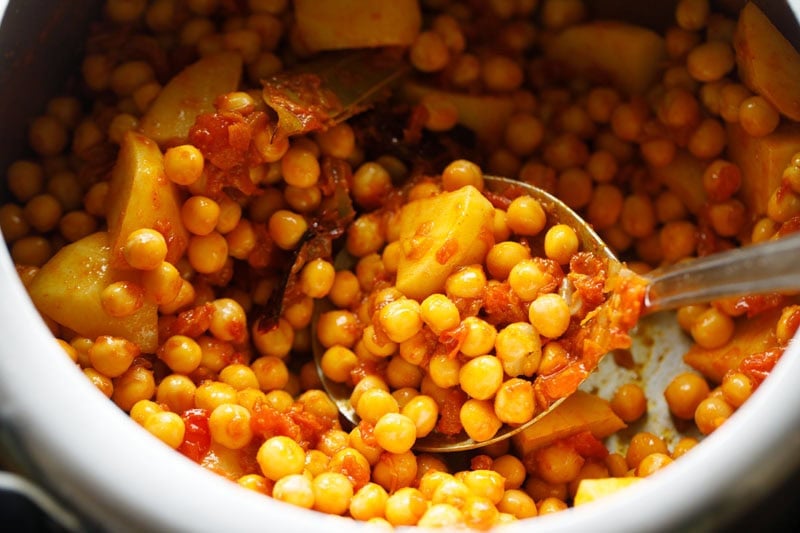

13. Add 2½ cups water and blend once more. Let this combination simmer on medium-low warmth for two to three minutes.
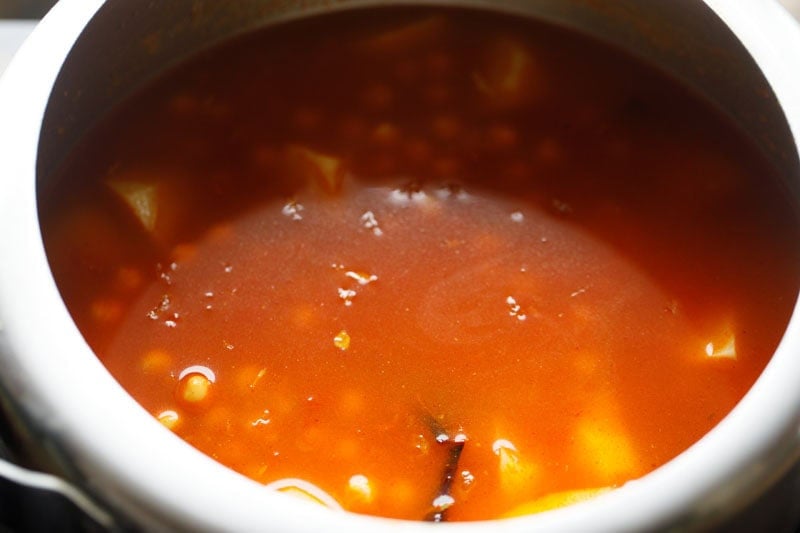

14. Seal the cooker tightly with its lid and strain prepare dinner on medium warmth for quarter-hour. As soon as the strain drops naturally within the cooker, then open the lid.
Test if the peas have softened effectively. Additionally, examine the consistency of the Ghugni.
If the peas are al dente or undercooked, strain prepare dinner once more for five minutes or extra. Add water, if wanted when strain cooking the second time.
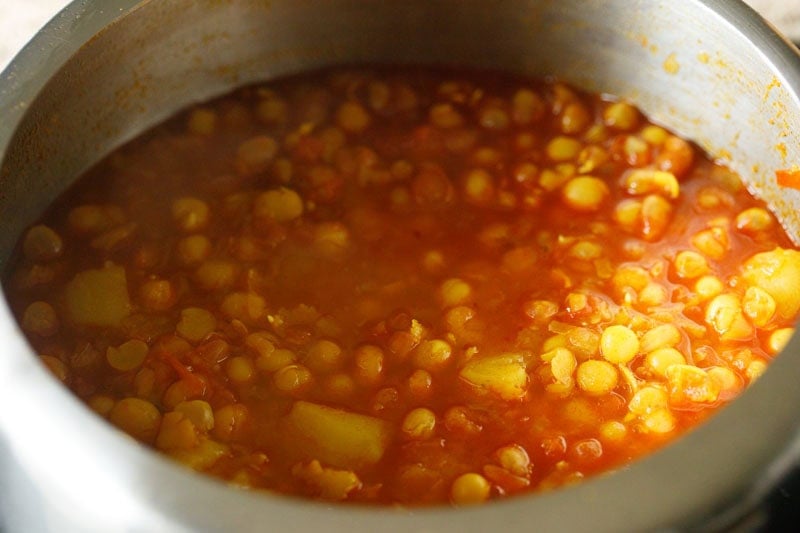

15. If the consistency is runny, hold the cooker on stovetop and simmer till the consistency thickens.
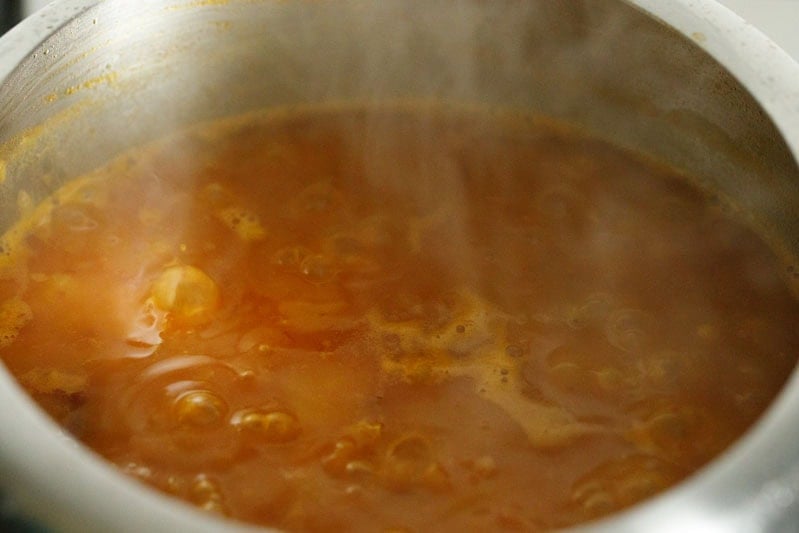

16. The peas should be softened effectively and there should not be any chew to them. Take away the purple chilies when simmering additional as they’ll soften an excessive amount of and disintegrate into the curry.
The consistency shouldn’t be runny nor very thick, however type of in-between.
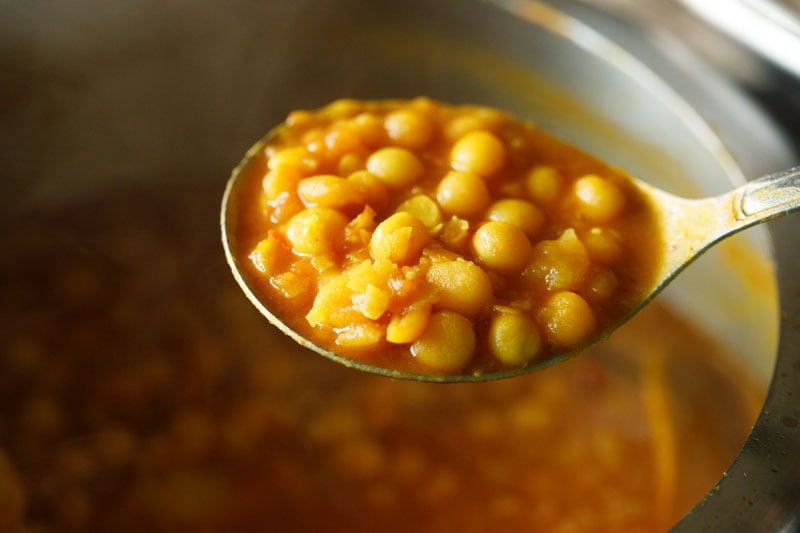

17. Lastly, add ¼ teaspoon bhaja masala or garam masala.
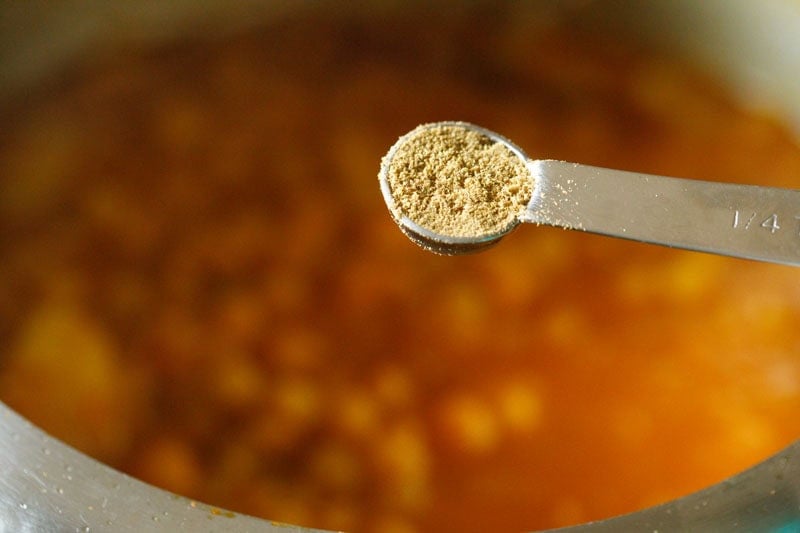

18. Add 1 to 2 tablespoons chopped coriander leaves. Combine effectively and put aside. Style take a look at and add extra salt, if required.
Remember the fact that the consistency will thicken because the dish cools. So, you have to so as to add some water if you reheat it.


Make Tamarind Water
19. Rinse and soak 2 tablespoons dried tamarind in ½ cup scorching water for 20 to half-hour.
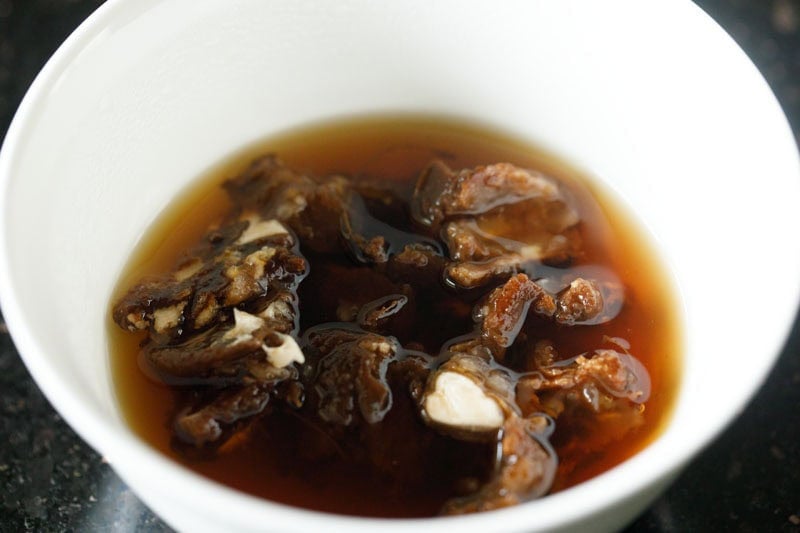

20. Squeeze the softened tamarind and extract its pulp within the water itself. Pressure this tamarind water and put aside in a separate bowl.
Additionally, chop finely onions, inexperienced chilies and coriander leaves. You can additionally take into account including tomatoes, cucumber and uncooked mango, when in season for the topping. Lower a lemon in quarters.
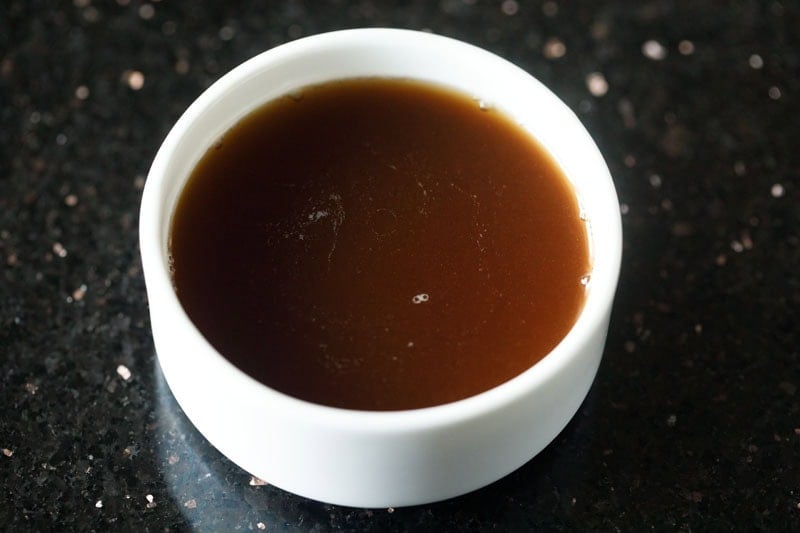

Make Ghugni Chaat
21. Pour the Ghugni in a bowl.


22. High with some chopped onions, inexperienced chilies, tamarind water as wanted, coriander leaves and sev.
Don’t forget to sprinkle some bhaja masala or chaat masala. Drizzle some lemon juice.
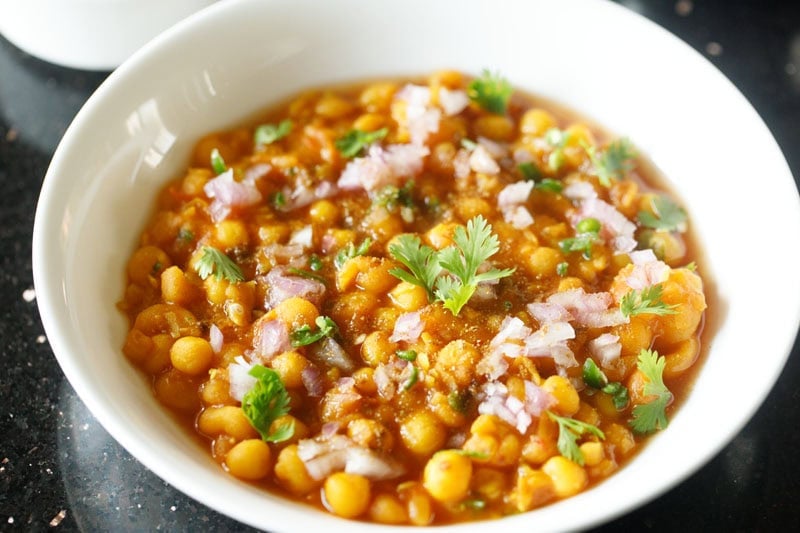

23. Combine and revel in Ghugni Chaat.
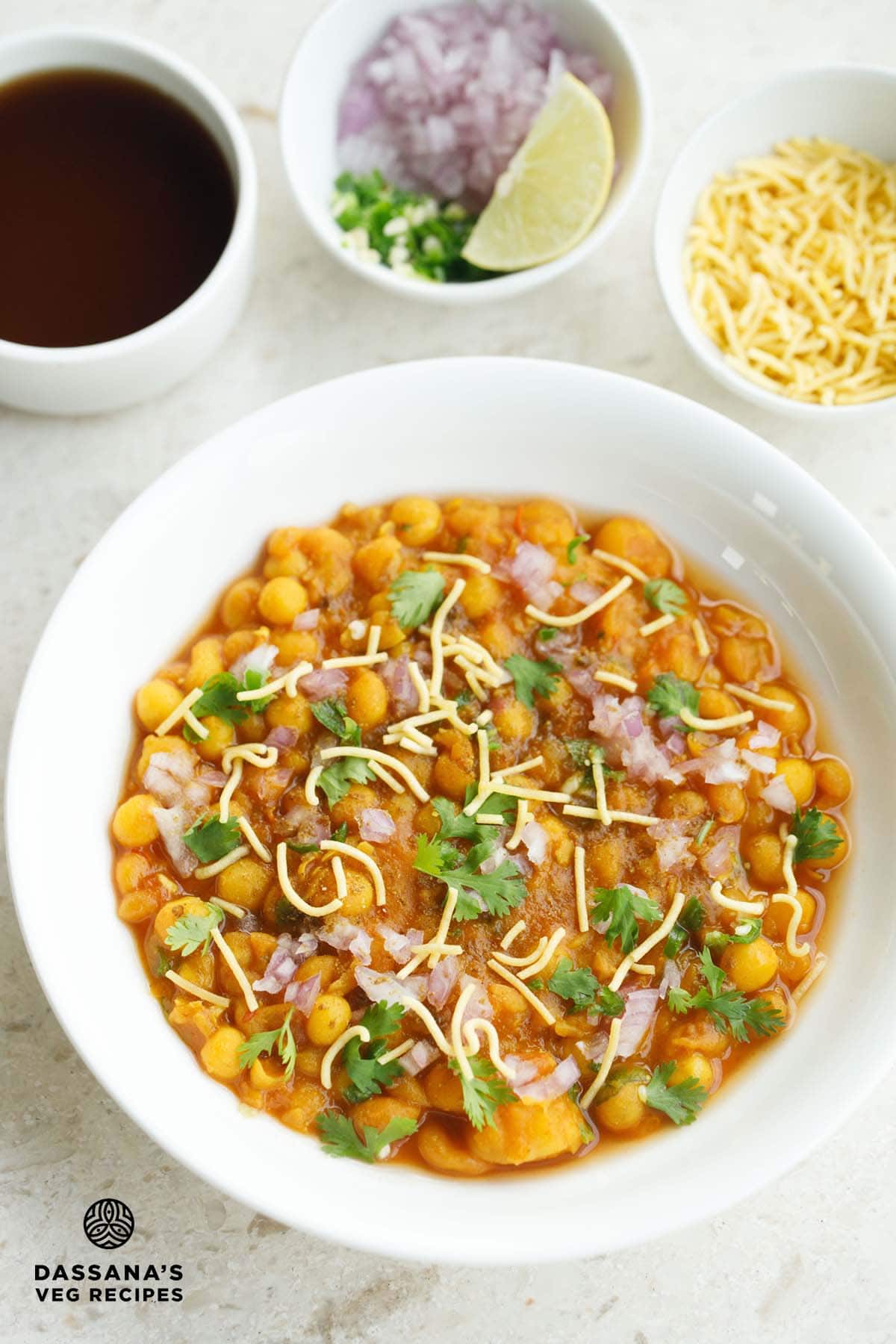

Serving Solutions
- Ghugni Chaat could be relished by itself or paired with puffed rice (muri), topped with chopped greens and tamarind chutney. It additionally makes a scrumptious facet dish when served with calmly toasted bread, Luchi, Poori or Paratha.
- For a real street-style expertise of this Ghugni Recipe, serve it in small bowls or eco-friendly leaf bowls together with a picket spoon.
- To recreate the normal Kolkata chaat type, high it with finely chopped onions, inexperienced chilies, tomatoes, boiled potatoes, a splash of black salt and a squeeze of lemon juice. Add a sprinkle of sev, crushed papdi or some puffed rice for a pleasant mixture of textures.
- Choose a candy and tangy taste? Swap the tamarind water for tamarind chutney for a richer style.
- Potatoes may also be sautéed or fried individually for added texture somewhat than being cooked with the peas.
- For an Odia-style twist, add some chopped or sliced coconut. Evenly fry the coconut in oil earlier than mixing it into the Ghugni for added richness.
- In Odisha and Assam, recent grated coconut or uncooked mango is usually used as a garnish so as to add a refreshing tang and additional texture within the Ghugni Recipe.
- For a ultimate contact, drizzle a little bit of ghee or mustard oil over the completed dish for an additional layer of taste.
Professional Suggestions
- Peas (white or yellow peas/motor): Soak the dried peas for not less than 8 hours or in a single day to make sure they soften correctly. In case you’re utilizing recent or frozen inexperienced peas, bear in mind they prepare dinner a lot faster, so alter the cooking time accordingly.
- Cooking peas: The peas needs to be totally cooked till they’re delicate and barely mushy – not agency or al dente. This whole one pot dish may also be cooked in an Prompt Pot.
- Use of mustard oil: Mustard oil provides a daring, pungent taste that defines conventional Ghugni. Don’t skip it – it’s a key ingredient for the dish’s depth and authenticity.
- Spices: For an genuine taste, use roasted cumin powder and bhaja masala, the normal Bengali roasted spice mix. If bhaja masala isn’t obtainable, garam masala is an effective substitute. A contact of black salt or chaat masala may also be added for a touch of tang.
- Tamarind or lemon juice: Tamarind water brings the signature tang to the dish. You possibly can swap it with lemon juice, amchur (dried mango powder), dry pomegranate seeds powder and even dried kokum for the same bitter word.
- Beans or lentil variations: For a Bihari-style model, strive utilizing black chickpeas (kala chana). You can even use inexperienced peas – recent, frozen or dried – relying on what you may have readily available.
FAQs
Ghugni doesn’t have a direct English title, as it’s a conventional regional dish from Jap India. Nonetheless, it may be described in English as a spiced white pea curry. This flavorful curry made with soaked and cooked dried peas is usually served as road meals or a facet dish with flatbreads or puffed rice (muri).
Sure, Ghugni Recipe is of course vegan and gluten-free. It’s constructed from dried white or yellow peas cooked with spices, onions, tomatoes and mustard oil – no dairy or gluten-containing substances are used within the conventional recipe.
Completely! Ghugni is a healthful and protein-rich dish, particularly when made with minimal oil. The peas are an incredible supply of plant-based protein, fiber and important vitamins. It’s filling, nutritious, and generally is a wholesome addition to your weight-reduction plan when ready with much less oil and served with recent toppings.
Bengali Ghugni Recipe is usually made with dried white or yellow peas which can be soaked after which pressure-cooked. It’s flavored with mustard oil, bhaja masala (a Bengali roasted spice mix), turmeric, ginger, garlic, onions and tomatoes. It’s usually completed with tamarind water or lemon juice and topped with chopped onions, inexperienced chilies, and generally boiled potatoes or coconut for added taste and texture.
Sure, it may be made minus onion and garlic. Temple-style Odia Ghugni Recipe and a few Assamese variations are made with out onion and garlic. You possibly can taste the curry utilizing simply ginger, inexperienced chilies, cumin and asafoetida (hing).
Extra Bengali Recipes To Strive!
Please remember to price the recipe within the recipe card or go away a remark under you probably have made it. For extra vegetarian inspirations, Signal Up for my emails or observe me on Instagram, Youtube, Fb, Pinterest or Twitter.
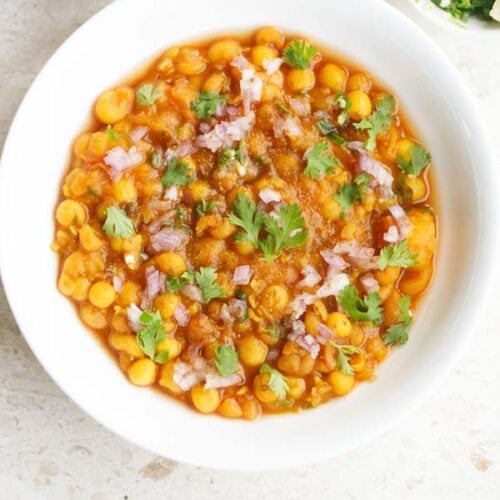

Ghugni Recipe | How one can make Ghugni Chaat
Ghugni is a flavorful road meals from Jap India made with dried white peas simmered in a spiced onion-tomato curry. Typically cooked in mustard oil with entire spices and bhaja masala, it’s topped with onions, inexperienced chilies, coriander, and lemon. Served as a snack or gentle meal with bread, poori, or as Ghugni Chaat with tamarind water, sev, and puffed rice.
Prep Time 10 minutes
Prepare dinner Time 25 minutes
Soaking Time 9 hours
Whole Time 9 hours 35 minutes
Stop your display from going darkish whereas making the recipe
Soaking White Peas
Firstly rinse the dried white peas in water a number of instances.
Soak the rinsed white peas in water for 9 to 10 hours or in a single day.
They may plump up in dimension the subsequent day. Drain the water. Rinse the dried peas a couple of instances once more with recent water. Drain all of the water and set the soaked peas apart.
Making Ghugni
Place a 3 litre strain cooker on the stovetop.
Preserve warmth low or medium-low.
- When the oil turns into shot, add cinnamon, cardamom, tej patta, dry purple chilli and cloves. At this level you too can add ½ teaspoon cumin seeds if you don’t add cumin powder later.
Permit the spices to crackle on low to medium-low warmth making certain they don’t burn.
Add within the finely chopped onions. Sauté till onions are softened or a lightweight golden.
Add ginger garlic paste and sauté for about 20 to 30 seconds on a low warmth or till their uncooked aroma dissipates.
Add the finely chopped tomatoes and sauté for about 2 minutes on medium-low to medium warmth.
Subsequent add the bottom spices – Kashmiri purple chilli powder, turmeric powder, cumin powder, coriander powder.
Combine totally and sauté till the onion-tomato masala seems shiny with the tomatoes softened utterly. Additionally, you will see a little bit of oil separating on the sides.
If the masala begins sticking onto the cooker, add a splash of water and blend. It can be crucial that the bottom spices prepare dinner effectively.
Add the soaked and rinsed peas, chopped potatoes and season with sugar and add salt in keeping with style.
Stir and blend to mix.
Add water and blend once more.
Let this combination simmer for two to three minutes on medium-low warmth.
Seal the cooker tightly with its lid and strain prepare dinner for quarter-hour on medium warmth.
As soon as the strain drops naturally within the cooker, then solely open the lid.
Test if the peas have softened effectively. Additionally examine the consistency of the ghugni.
If the peas are al dente or undercooked, strain prepare dinner once more for five minutes or extra. Add water if wanted when strain cooking the second time.
If the consistency is runny, hold the cooker on stovetop and simmer ghugni till the consistency thickens.
- The peas should be softened effectively and there should not be any chew to them.Take away the purple chillies when simmering additional as they’ll soften an excessive amount of and disintegrate into the curry.
The consistency of ghugni is medium—not too runny or thick. It has sufficient gravy to coat the peas, giving it a clean, barely saucy texture that is good for serving with poori, paratha, or as a chaat with puffed rice and different toppings.
Lastly add bhaja masala or garam masala powder.
Add chopped coriander leaves. Combine effectively and put aside. Test the style and add extra salt if wanted.
Remember the fact that the consistency will thicken as ghughni cools. So you have to so as to add some water if you reheat it.
Making Tamarind Water
Rinse after which soak the dried tamarind in ½ cup scorching water for 20 to half-hour.
Squeeze the softened tamarind and extract its pulp within the water itself.
Pressure this tamarind water and put aside.
Extra Preparation
Additionally chop finely onions, inexperienced chillies and coriander leaves. You can additionally take into account including tomatoes, cucumber and unripe inexperienced mango, when in season for the topping. Chop the lemon in quarters.
Assembling & Serving Ghugni Chaat
- Pour ghughni in serving bowls. High with some chopped onions, inexperienced chillies, tamarind water, coriander leaves, and sev. Don’t forget to sprinkle some bhaja masala or chaat masala on the ghughni.
Drizzle some lemon juice. Combine and benefit from the Ghugni Chaat
You possibly can take pleasure in Ghugni by itself or serve with calmly toasted bread, luchi or poori.
- In case you like some candy style, as a substitute of tamarind water, use candy and tangy Tamarind Chutney.
You can even add some sliced or chopped coconut. Fry the chopped coconut in some oil and add to the ghughni.
Optionally, drizzle a little bit of mustard oil or ghee on the ghugni whereas serving.
- Peas: Use good high quality dried peas that aren’t previous or aged. Keep in mind to soak the dried peas in water for not less than 9 hours. Optionally you may use dried inexperienced peas, kala chana (black chickpeas) as a substitute of white peas. One other variation is to make the dish with recent or frozen inexperienced peas.
- Cooking: These peas after soaking get cooked very well in a strain cooker. Don’t attempt to prepare dinner them in a pan or stovetop as they could take hours to prepare dinner and should not prepare dinner effectively. Make it possible for the peas have softened very well and have a mushy texture. Don’t prepare dinner the peas till al dente texture.
- Potatoes: The potato cubes could be sautéed or fried individually, as a substitute of cooking along with the dried peas.
- Cumin: Choose to skip the cumin powder and add cumin seeds, whereas tempering the entire spices. Since I’ve added cumin powder, I selected to not add the cumin seeds.
- Pink Chillies: Including purple chillies are optionally available. Guarantee to make use of a milder selection, as a warmer one will make your ghughni very spicy.
- Spicing: Regulate the spices as wanted. For a spicy ghugni chaat add extra inexperienced chillies as a topping.
- Spices: Use bhaja masala (a Bengali roasted spice combine) for authenticity. In case you do not need bhaja masala, add garam masala. Add a pinch of black salt or chaat masala for tanginess.
- Tamarind or Lemon Juice: Tamarind water provides the signature tangy word. You possibly can substitute with lemon juice or amchur (dry mango powder)
- Mustard Oil: Conventional Ghugni is finest made in mustard oil for its pungency and depth. So don’t skip on it. It’s a necessary ingredient.
Vitamin Information
Ghugni Recipe | How one can make Ghugni Chaat
Quantity Per Serving
Energy 307 Energy from Fats 72
% Every day Worth*
Fats 8g12%
Saturated Fats 1g6%
Polyunsaturated Fats 2g
Monounsaturated Fats 4g
Sodium 349mg15%
Potassium 817mg23%
Carbohydrates 48g16%
Fiber 16g67%
Sugar 10g11%
Protein 14g28%
Vitamin A 501IU10%
Vitamin B1 (Thiamine) 0.4mg27%
Vitamin B2 (Riboflavin) 0.2mg12%
Vitamin B3 (Niacin) 2mg10%
Vitamin B6 0.3mg15%
Vitamin C 27mg33%
Vitamin E 0.5mg3%
Vitamin Ok 14µg13%
Calcium 78mg8%
Vitamin B9 (Folate) 153µg38%
Iron 4mg22%
Magnesium 87mg22%
Phosphorus 231mg23%
Zinc 2mg13%
* % Every day Values are primarily based on a 2000 calorie weight-reduction plan.
